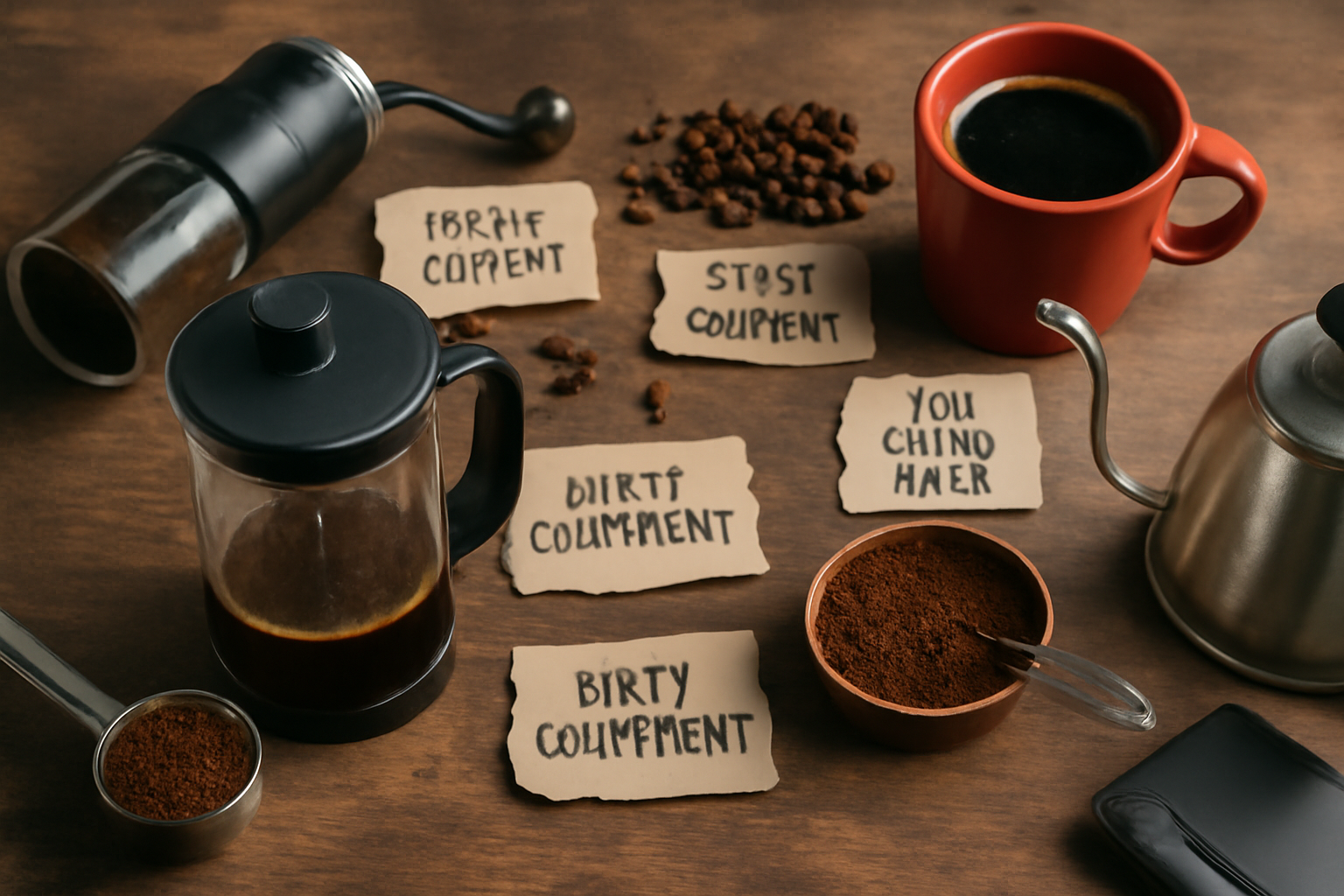Brewing the perfect cup of coffee at home can feel like a daunting task, especially with so many variables at play. From the grind size and water temperature to the brewing method, there’s a lot that can go wrong. Even if you follow every guideline, small mistakes can still lead to a less-than-ideal cup. The good news? Most of these mistakes are easy to fix, and once you learn how to avoid them, you’ll be able to brew a consistently great cup of coffee every time. In this article, we’ll discuss some of the most common coffee brewing mistakes and provide tips on how to avoid them.
1. Using Stale Coffee Beans
One of the most common mistakes people make when brewing coffee is using stale or pre-ground coffee. Coffee beans are at their peak freshness immediately after being roasted, and they start to lose their aroma and flavor within a few days. When you use stale beans, your coffee will lack the depth and vibrancy that fresh beans provide.
Why Fresh Coffee Beans Matter
Freshly roasted coffee beans retain more of their natural oils and flavors, giving you a cup that’s more aromatic, flavorful, and balanced. The longer coffee beans sit after roasting, the more these essential oils degrade, leading to a flat, stale taste.
How to Avoid This Mistake:
- Buy small quantities: Only buy as much coffee as you’ll consume within 1-2 weeks to ensure freshness.
- Grind just before brewing: Whole beans stay fresher for longer. Invest in a good grinder and grind your beans just before brewing to preserve their freshness.
- Store your beans properly: Store your beans in an airtight container away from heat, light, and moisture. Avoid keeping them in the fridge, as this can introduce moisture and odors.
2. Incorrect Grind Size
Grind size plays a significant role in how your coffee extracts flavors during brewing. Using the wrong grind size for your chosen brewing method can result in over-extraction or under-extraction, leading to coffee that’s either too bitter or too weak.
Why Grind Size Matters
Each brewing method has its ideal grind size. For example:
- Coarse grind is best for methods like French Press and cold brew.
- Medium grind is perfect for drip coffee makers and pour-over.
- Fine grind works well for espresso and Aeropress.
If the grind is too fine for a French press, for example, the coffee will become over-extracted and taste bitter. If the grind is too coarse for espresso, the water will flow through too quickly, leading to a weak, under-extracted shot.
How to Avoid This Mistake:
- Use a burr grinder: Burr grinders provide a consistent grind size, which is key to making good coffee. Blade grinders often produce uneven grinds, which can affect extraction.
- Match the grind size to the brewing method: If you’re unsure about the grind size for a particular method, start with the recommended grind for that method and adjust to taste.
3. Not Measuring Your Coffee
A common mistake, especially for beginners, is not measuring the coffee grounds and water. Many people simply estimate, which can lead to an inconsistent cup. Too much coffee can result in a bitter, overpowering brew, while too little coffee will lead to a weak and underwhelming cup.
Why Measuring Matters
By measuring the coffee and water, you ensure consistency in your brew, so each cup tastes the same. It’s also the best way to achieve the right balance of flavors, strength, and body. Using a scale to measure both the coffee and water allows you to control the ratio and avoid over- or under-brewing.
How to Avoid This Mistake:
- Invest in a digital scale: A scale helps you measure the precise amount of coffee and water you need. The standard coffee-to-water ratio is 1:15, meaning for every gram of coffee, use 15 grams of water.
- Use the right equipment: If you’re brewing with a drip machine or French press, they may have their own recommended ratios that you can follow for optimal results.
4. Using Water That’s Too Hot or Too Cold
Water temperature has a huge impact on how your coffee extracts. If the water is too hot, it can over-extract the coffee, leading to a bitter, harsh taste. On the other hand, if the water is too cold, it will under-extract the coffee, leaving you with a sour, weak cup.
Why Water Temperature Matters
The ideal brewing temperature for coffee is between 195°F and 205°F (90°C to 96°C). This range allows for the optimal extraction of flavors, balancing acidity, sweetness, and bitterness.
How to Avoid This Mistake:
- Use a thermometer: If you’re brewing manually, use a thermometer to ensure your water is in the right temperature range. If you don’t have a thermometer, let the water boil and then let it sit for about 30 seconds to cool slightly before brewing.
- Avoid boiling water: Boiling water (212°F or 100°C) can scorch the coffee grounds, making your coffee bitter. Always use water just below boiling for the best extraction.
5. Not Preheating Your Equipment
Preheating your equipment may seem like an extra step, but it can make a big difference in your coffee. Cold equipment can cause the brewing temperature to drop, leading to uneven extraction and a lackluster cup of coffee.
Why Preheating Matters
By preheating your equipment, such as your coffee maker, French press, or mug, you ensure that your coffee brews at the optimal temperature. This helps maintain consistency and brings out the best flavors in your coffee.
How to Avoid This Mistake:
- Preheat your brewing device: Before brewing, run hot water through your brewing device or pour hot water into your mug to warm them up.
- Use warm cups: If you’re using a glass or ceramic mug, preheat it with hot water to prevent your coffee from cooling too quickly.
6. Not Cleaning Your Equipment
Coffee oils and residue from previous brews can build up over time, affecting the flavor of your coffee. If your equipment is not properly cleaned, it can result in a bitter or rancid taste in your coffee.
Why Cleaning Matters
Residue and oils from previous brews can get stuck in your equipment, impacting the taste of your coffee. Regular cleaning ensures that you’re brewing with fresh equipment and that old coffee oils don’t spoil the taste of your current brew.
How to Avoid This Mistake:
- Clean your coffee maker regularly: Follow the manufacturer’s instructions for cleaning your coffee machine, French press, pour-over dripper, and grinder. Be sure to rinse out any filters, brewing baskets, and carafes after every use.
- Descale your coffee maker: Hard water can lead to mineral buildup inside your machine. Use a descaling solution or a mixture of vinegar and water to clean your machine every few months.
7. Over-Extracting or Under-Extracting Your Coffee
Over-extraction happens when you leave your coffee grounds in contact with water for too long, resulting in bitterness and harsh flavors. Under-extraction occurs when you don’t allow the coffee grounds to brew long enough, resulting in weak, sour coffee.
Why Extraction Time Matters
Each brewing method has a recommended brew time, and sticking to it is essential for balanced extraction. For example, espresso requires a shorter extraction time (around 25-30 seconds), while French press coffee should steep for around 4-5 minutes. Pour-over brewing generally takes 3-4 minutes, depending on the grind size and the flow of water.
How to Avoid This Mistake:
- Follow recommended brew times: Each brewing method has its own ideal brew time. Set a timer and avoid distractions while your coffee is brewing.
- Adjust your grind size: If your coffee is over-extracting or under-extracting, try adjusting the grind size. A coarser grind slows extraction, while a finer grind speeds it up.

I’m an economist with 15 years of experience in strategic planning and a lifelong passion for wellness and natural living. As a self-learner, I created Herbalife Balance to share insights on healthy eating, mindful habits, and an active lifestyle. Tennis enthusiast and nature lover, I believe in balance as a path to well-being. Through this blog, I help others live healthier, more conscious lives.

